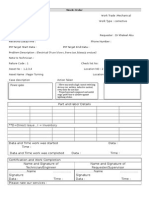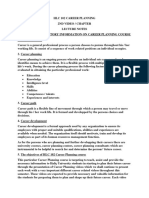Tut 2
Tut 2
Uploaded by
Ibraheem KhressCopyright:
Available Formats
Tut 2
Tut 2
Uploaded by
Ibraheem KhressOriginal Title
Copyright
Available Formats
Share this document
Did you find this document useful?
Is this content inappropriate?
Copyright:
Available Formats
Tut 2
Tut 2
Uploaded by
Ibraheem KhressCopyright:
Available Formats
Heat and Mass Transfer (MEL242)
Tutorial Sheet 2
1. An exterior wall of a house may be approximated by a 4-in layer of common brick (k = 0.7
W/m.
o
C) followed by a 1.5-in layer of gypsum plaster (k=0.48 W/m.
o
C). What thickness of
loosely packed rock-wool insulation (k=0.065 W/m.
o
C) should be added to reduce the heat
transfer through the wall by 80 percent?
2. Steam flowing through a long, thin walled pipe maintains the pipe wall at a uniform
temperature of 500 K. The pipe is covered with an insulation blanket comprised of two
different materials, A and B. The interface between the two materials may be assumed to have
an infinite contact resistance, and the entire outer surface is exposed to air for which T
= 300
K and h = 25 W/m
2
K.
a. Sketch the thermal circuit of the system. Label all pertinent nodes and resistances.
b. For the prescribed conditions, what is the total heat loss from the pipe? What are the outer
surface temperatures T
s,2
(A) and T
s,2
(B)?
3. One side of a copper (k = 385 W/m K) block 5 cm thick is maintained at 260
o
C. The other
side is covered with a layer of fiber glass (k = 0.05 W/m K) 2.5 cm thick. The outside of the
fiber glass is maintained at 38
o
C and the total heat flow is 44 kW. What is the area of the
slab?
4. A plane wall is constructed of a material having thermal conductivity that varies as the square
of temperature according to the relation k = k
o
(1+ T
2
). Derive an expression for the heat
transfer in such a wall.
5. A certain material has a thickness of 30 cm and a thermal conductivity of 0.04 W/m.
o
C. At a
particular instant in time the temperature distribution with x, the distance from the left face, is
T = 150x
2
- 30x, where x is in meters. Calculate the heat flow rates at x = 0 and x = 30 cm. Is
the solid heating up or cooling down?
6. Calculate the critical radius of insulation for asbestos (k = 0.17 W/m
o
C) surrounding a pipe
and exposed to room air at 20
o
C with h = 3 W/m
2
.
o
C. Calculate the heat loss from a 200
o
C, 5
cm diameter pipe when covered with the critical radius of insulation and without insulation.
7. Derive an expression for critical radius of insulation for a sphere.
8. A 1 mm diameter wire is maintained at a temperature of 400
o
C and exposed to a convection
environment at 40
o
C with h = 120 W/m
2 o
C. Calculate the thermal conductivity which will
just cause an insulation thickness of 0.2 mm to produce a critical radius.
How much of this insulation must be added to reduce the heat transfer by 75 percent from that
which would be experienced by the bare wire?
You might also like
- Life On Mars Poems by Tracy K Smith 1555975844 PDFDocument5 pagesLife On Mars Poems by Tracy K Smith 1555975844 PDFMonica Montero0% (1)
- SQL Questions & AnswersDocument9 pagesSQL Questions & AnswersTsehayou SieleyNo ratings yet
- BCM Captiva 1 ConectorDocument4 pagesBCM Captiva 1 Conectorjulio montenegroNo ratings yet
- Tut 2Document1 pageTut 2Kumaran PalaniNo ratings yet
- HMT Worksheet OneDocument7 pagesHMT Worksheet OneAbdulaziz AhmedNo ratings yet
- Assignment No. 1Document2 pagesAssignment No. 1venkybagalNo ratings yet
- Heat Transfer Problem Sheet PDFDocument3 pagesHeat Transfer Problem Sheet PDFDerek101johnson100% (1)
- Assignment No 1Document3 pagesAssignment No 1Sumit NagpalNo ratings yet
- Process Heat Transfer Question BankDocument10 pagesProcess Heat Transfer Question BankMadhuNo ratings yet
- Work Sheet 1 2022Document6 pagesWork Sheet 1 2022Fikadu GonfaNo ratings yet
- HMT Unit-1 PDFDocument3 pagesHMT Unit-1 PDFAnkita MishraNo ratings yet
- Heat and Mass Transfer WorksheetDocument5 pagesHeat and Mass Transfer WorksheetBISRAT YIHUNNo ratings yet
- Conduction Tutorial Sheet 2Document3 pagesConduction Tutorial Sheet 2Charlotte BNo ratings yet
- Conduction Tutorial Sheet 2Document3 pagesConduction Tutorial Sheet 2Charlotte BNo ratings yet
- Work 4 - Perpandas-2019 PDFDocument3 pagesWork 4 - Perpandas-2019 PDFrafiqi khairalNo ratings yet
- Work 4 - Perpandas-2019Document3 pagesWork 4 - Perpandas-2019hungNo ratings yet
- Heat Transfer - Sheet Two ConductionDocument4 pagesHeat Transfer - Sheet Two ConductionMichael EmadNo ratings yet
- Practice Set 1 (Basic Questions) (1 Copy)Document3 pagesPractice Set 1 (Basic Questions) (1 Copy)TutuNo ratings yet
- ME 2251 Heat and Mass TransferDocument2 pagesME 2251 Heat and Mass TransferChinnadurai LakshmananNo ratings yet
- HMT AssignmentDocument2 pagesHMT AssignmentAditya KumarNo ratings yet
- Tutorial 2-1Document4 pagesTutorial 2-1chandan rajNo ratings yet
- Problems 2Document4 pagesProblems 2Ebenezer EffisahNo ratings yet
- Heat Transfer Practice ProblemDocument2 pagesHeat Transfer Practice ProblemmkbNo ratings yet
- Tutorial 2Document0 pagesTutorial 2xhotdogzxNo ratings yet
- Heat and Mass Transfer (MCC 15102) Assignmnet - 1: A F B C D EDocument4 pagesHeat and Mass Transfer (MCC 15102) Assignmnet - 1: A F B C D ERotten AppleNo ratings yet
- Sheet 1Document3 pagesSheet 1Basem Abd ElazizNo ratings yet
- One Dimensional Steady State ConductionDocument1 pageOne Dimensional Steady State ConductionMelethil SyamNo ratings yet
- HT Notes For ESEDocument25 pagesHT Notes For ESEM BhurleNo ratings yet
- Tutorial Number4conductionDocument2 pagesTutorial Number4conductionNiraj PSNo ratings yet
- HT Important Questions For End ExamDocument10 pagesHT Important Questions For End ExamSandeepKattaNo ratings yet
- Z - CIT HMT Question BankDocument31 pagesZ - CIT HMT Question BankVishal SpNo ratings yet
- Heat Transfer Assignment 1Document3 pagesHeat Transfer Assignment 1Yehia Raef0% (1)
- Assignment 1Document6 pagesAssignment 1Menna TantawiNo ratings yet
- Conduction & ConvectionDocument5 pagesConduction & Convectionralona2648No ratings yet
- DST Assignment 2Document2 pagesDST Assignment 2Angel BlacioNo ratings yet
- Tutorial 2 ConductionDocument3 pagesTutorial 2 Conductionakshitppe11No ratings yet
- HMTDocument4 pagesHMTsumeetsharma270% (1)
- Tutorial - Conduction Heat TransferDocument3 pagesTutorial - Conduction Heat TransferDayanidiNo ratings yet
- Ch3 HeatTransfer 2Document27 pagesCh3 HeatTransfer 2abubackersiddieq0% (1)
- Sheet 1Document10 pagesSheet 1محمود بسيوني نصارNo ratings yet
- HMT16 MarksDocument12 pagesHMT16 MarkstagoreboopathyNo ratings yet
- Ejercicios TransferenciaDocument5 pagesEjercicios TransferenciaPablo RuizNo ratings yet
- Heat Transfer Conduction TutorialDocument2 pagesHeat Transfer Conduction TutorialchawarepNo ratings yet
- Problems: Heat TransferDocument7 pagesProblems: Heat TransferKinna VnezhNo ratings yet
- Department of Chemical Engineering, NITK Assignment - 1: Heat Transfer (CH250)Document6 pagesDepartment of Chemical Engineering, NITK Assignment - 1: Heat Transfer (CH250)UdayNo ratings yet
- Cadabadi - T1 - Taller ConduccionDocument5 pagesCadabadi - T1 - Taller ConduccionAndres FigueroaNo ratings yet
- Updated ProblemsDocument3 pagesUpdated Problemsmahmoud koriemNo ratings yet
- Example 2-Heat ConductionDocument4 pagesExample 2-Heat Conductionqusai almshaqbehNo ratings yet
- Ch3 HeatTransfer 2Document27 pagesCh3 HeatTransfer 2Fernando EsquivelNo ratings yet
- Assignment IDocument6 pagesAssignment IPrerna JainNo ratings yet
- Assignment 3 2Document5 pagesAssignment 3 2Jigyanshu PatiNo ratings yet
- HT Assignment-1Document1 pageHT Assignment-1Karthikeya Kvs0223No ratings yet
- MEEG 306 Tutorial Revised May 2019Document30 pagesMEEG 306 Tutorial Revised May 2019sagar100% (1)
- 34 Tutorial 1 HT1Document2 pages34 Tutorial 1 HT1jameeloNo ratings yet
- HT QB A2Document27 pagesHT QB A2Shakil MaddilaNo ratings yet
- Tutorial Sheet 3Document10 pagesTutorial Sheet 3kushalNo ratings yet
- Tutorial 7 1Document2 pagesTutorial 7 1GSaurav DahalNo ratings yet
- HMT 113401 Anna UnivDocument4 pagesHMT 113401 Anna Univsathiya_ramNo ratings yet
- Problem SetDocument4 pagesProblem Set12 34No ratings yet
- 2014 SOLIDWORKS Help - Equation Driven CurvesDocument2 pages2014 SOLIDWORKS Help - Equation Driven CurvesIbraheem KhressNo ratings yet
- 111Document1 page111Ibraheem KhressNo ratings yet
- Post Info - LatheDocument2 pagesPost Info - LatheIbraheem KhressNo ratings yet
- Fuse Blows Power Lost Motor(s) OverheatDocument2 pagesFuse Blows Power Lost Motor(s) OverheatIbraheem KhressNo ratings yet
- Running On Windows 64 BitDocument8 pagesRunning On Windows 64 BitIbraheem KhressNo ratings yet
- Work OrderDocument2 pagesWork OrderIbraheem KhressNo ratings yet
- 3 1 Eight Forms CorrosionDocument20 pages3 1 Eight Forms CorrosionIbraheem KhressNo ratings yet
- Work Package 2: DR Jüri RiivesDocument34 pagesWork Package 2: DR Jüri RiivesIbraheem KhressNo ratings yet
- General Mech EnglishDocument19 pagesGeneral Mech EnglishIbraheem KhressNo ratings yet
- معادن سكندDocument15 pagesمعادن سكندIbraheem KhressNo ratings yet
- ReportDocument6 pagesReportIbraheem KhressNo ratings yet
- Docslide - Us Variable Frequency TransformerDocument20 pagesDocslide - Us Variable Frequency TransformerSuhail Ahmad SuhailNo ratings yet
- Problems: Circuitos Eléctricos Avanzados Ingeniería MecatrónicaDocument18 pagesProblems: Circuitos Eléctricos Avanzados Ingeniería MecatrónicaGonzalo Daniel Ramos MenaNo ratings yet
- Solar Panel DocumentationDocument19 pagesSolar Panel DocumentationYogesh ItankarNo ratings yet
- Move Play Through Traditional Games Lesson Plan Grade 4 Social May 29 18 UpdatedDocument8 pagesMove Play Through Traditional Games Lesson Plan Grade 4 Social May 29 18 UpdatedKyle Dhaniel VelascoNo ratings yet
- Yuuichi Katagiri's FeatsDocument17 pagesYuuichi Katagiri's FeatsSasuke UchihaNo ratings yet
- Metro Lite SystemDocument14 pagesMetro Lite SystemAPEXA ARYANo ratings yet
- EN21C Surf. RoughnessDocument1 pageEN21C Surf. RoughnessJujhaar BhinderNo ratings yet
- Torsiona-Flange SAE J744Document3 pagesTorsiona-Flange SAE J744Jamin SmtpngNo ratings yet
- 2021-11-06 23.45.15 CrashDocument5 pages2021-11-06 23.45.15 CrashIslam EleziNo ratings yet
- Die and MoldDocument120 pagesDie and MoldEr Faiyaz AhmedNo ratings yet
- Atajos IndesingDocument27 pagesAtajos IndesingEduardo MontalvoNo ratings yet
- Miniature Circuit Breaker - Acti9 Ic60 - A9V01225Document2 pagesMiniature Circuit Breaker - Acti9 Ic60 - A9V01225kiran pawarNo ratings yet
- HLC 102 Career Planning Course Video Chapter 2Document2 pagesHLC 102 Career Planning Course Video Chapter 2aboodabogusNo ratings yet
- Helicoflex: Spring Energized SealsDocument12 pagesHelicoflex: Spring Energized Seals_Asylum_No ratings yet
- Music6 - q1 - Melc4 - Improvisingrhythmicpatterns - v2 Week7-8Document20 pagesMusic6 - q1 - Melc4 - Improvisingrhythmicpatterns - v2 Week7-8Lea Mae T. NavarroNo ratings yet
- D71862GC10 1001 UsDocument4 pagesD71862GC10 1001 UsbugzbinnyNo ratings yet
- Passat B5 - Brakes. Technical DataDocument13 pagesPassat B5 - Brakes. Technical DataPedrojzbNo ratings yet
- Metoda e Shperndarjeve Te MomenteveDocument3 pagesMetoda e Shperndarjeve Te MomentevegertjaniNo ratings yet
- Involuntary Attraction Bombs Month 1Document4 pagesInvoluntary Attraction Bombs Month 1Ajay Kumar100% (2)
- LCD TV: Service ManualDocument14 pagesLCD TV: Service ManualPrabir Kumar SurNo ratings yet
- Pyramid Type Plate Bending MachineDocument10 pagesPyramid Type Plate Bending MachineAswin JosephNo ratings yet
- Beyerdynamic DT770 (Old Earpads)Document1 pageBeyerdynamic DT770 (Old Earpads)BurakBeyrekNo ratings yet
- DLL - Science 4 - Q2 - W5Document4 pagesDLL - Science 4 - Q2 - W5josefadrilanNo ratings yet
- Chapter 4 OrganizingDocument39 pagesChapter 4 OrganizingHanzel Dy NietesNo ratings yet
- Delta VFD E User Manual PDFDocument403 pagesDelta VFD E User Manual PDFInfoprime CharqueadasNo ratings yet


































































































